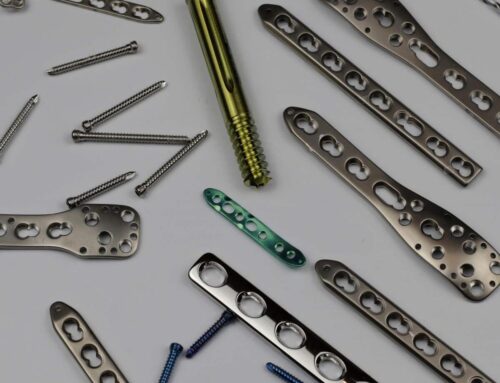Orthopedic implants and instruments are devices used in orthopedic surgeries to repair, replace, or support damaged or diseased bones, joints, and soft tissues. These implants and instruments are designed to restore function, alleviate pain, and improve the quality of life for patients with musculoskeletal conditions. Here’s a breakdown of both:
Orthopedic Implants:
Joint Replacement Implants: These implants are used to replace damaged or diseased joints, such as hips, knees, shoulders, and elbows. They are typically made of metals, ceramics, or polymers and mimic the function of the natural joint.
Fracture Fixation Devices: These implants are used to stabilize broken bones and facilitate their healing. They include plates, screws, nails, wires, and pins made of materials like stainless steel or titanium.
Spinal Implants: These implants are used in spinal surgeries to stabilize and support the spine. They include rods, screws, cages, and interbody fusion devices.
Orthobiologics: These are biological substances used in orthopedic surgeries to enhance bone healing, such as bone grafts, growth factors, and stem cells.
Orthopedic Instruments:
Surgical Tools: Instruments like scalpels, retractors, forceps, and scissors are used to manipulate tissues and perform precise surgical procedures.
Drills and Saw Blades: Orthopedic surgeries often require drilling into bones or cutting them, for which specialized drills and saw blades are used.
Implant Insertion Tools: These tools are designed specifically for the insertion and placement of orthopedic implants with precision.
Measuring Devices: Instruments such as calipers, rulers, and depth gauges are used to measure bone dimensions accurately during surgeries.
Implant Removal Instruments: Sometimes, implants need to be removed or revised due to various reasons. Specialized instruments are used for this purpose.
Orthopedic implants and instruments are developed and manufactured with strict quality standards to ensure safety, efficacy, and compatibility with the human body. They play a crucial role in modern orthopedic surgery, enabling surgeons to treat a wide range of musculoskeletal conditions effectively.
The use of orthopedic implants and instruments offers several benefits to patients, surgeons, and the healthcare system as a whole:
Improved Quality of Life: Orthopedic implants can restore function and mobility to patients with musculoskeletal conditions, enabling them to perform daily activities with reduced pain and improved independence. Joint replacements, for example, can significantly enhance mobility and alleviate pain, allowing patients to return to an active lifestyle.
Faster Recovery: Advanced surgical techniques and the use of specialized instruments allow for minimally invasive procedures, leading to shorter hospital stays, quicker recovery times, and faster return to normal activities for patients. Minimally invasive surgeries also result in less trauma to surrounding tissues and reduced postoperative pain.
Precision and Accuracy: Orthopedic instruments are designed to facilitate precise surgical techniques, ensuring accurate placement of implants and optimal alignment of bones. This precision helps minimize complications and improves the long-term success of orthopedic procedures.
Customization: Many orthopedic implants are available in various sizes and configurations, allowing surgeons to choose the most appropriate implant for each patient’s unique anatomy and condition. This customization contributes to better outcomes and patient satisfaction.
Longevity: High-quality orthopedic implants are designed to be durable and long-lasting, providing reliable support and function for many years. This longevity reduces the need for frequent revisions or replacements, saving both patients and the healthcare system from additional surgeries and costs.
Innovation and Advancements: Ongoing research and development in orthopedic technology lead to continuous improvements in implant materials, designs, and surgical techniques. These advancements result in better outcomes, reduced complications, and expanded treatment options for patients with orthopedic conditions.
Cost-Effectiveness: While initial costs of orthopedic implants and instruments may be significant, their long-term benefits in terms of improved patient outcomes, reduced healthcare utilization, and fewer revision surgeries can result in overall cost savings for the healthcare system.
Overall, orthopedic implants and instruments play a crucial role in modern orthopedic surgery, offering numerous benefits that ultimately improve the quality of life for patients with musculoskeletal conditions.




Leave A Comment